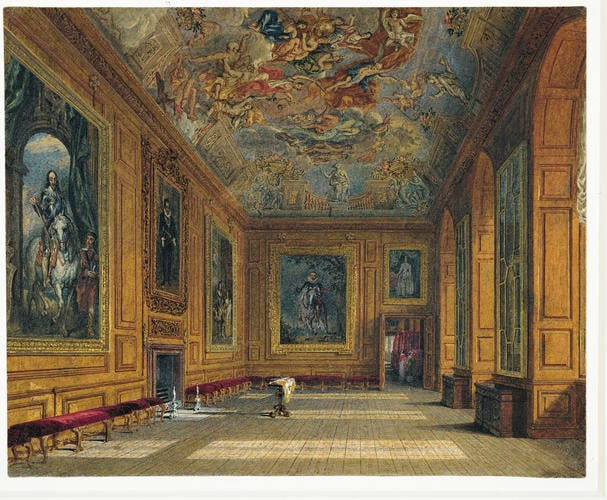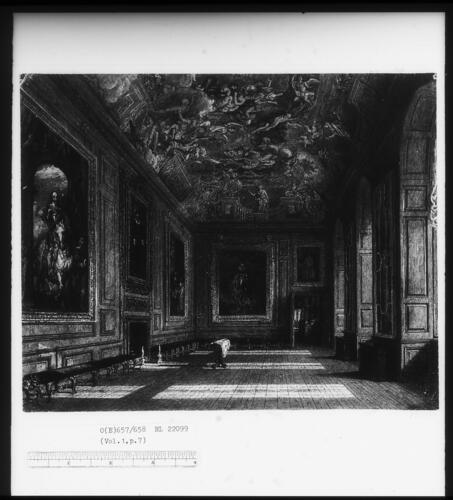Charles Wild (1781-1835)
Windsor Castle: The Queen’s Presence Chamber c. 1817
Watercolour with touches of bodycolour over pencil | 20.4 x 25.1 cm (sheet of paper) | RCIN 922099
-
A watercolour view of the interior of the Queen's Presence Chamber, Windsor Castle, prepared for one of the plates in William Henry Pyne's 'History of the Royal Residences' (1816-1819). Engraved by J. Bennett, the print published 1.4.1817.
As can be seen in this watercolour, the Queen's Presence Chamber was in the early nineteenth century used as a space to display large full-length paintings. Reading left to right these are Van Dyck's equestrian portrait of Charles I (RCIN 405322), his James I (405670) and Family of Charles I (the 'Great Piece', 405353). On the wall facing us appears Rubens's equestrian Don Roderigo Calderon (404393) and Princess Dorothea of Brunswick as an overdoor (404963). By 1837 some of the large paintings had been removed and four tapestries from the Story of Esther series, made by the Gobelins Tapestery Manufactory in the late eighteenth century, had been installed. Originally this room was very sparsely furnished.
Pyne's 'History of the Royal Residences' was a three-volume publication which encompassed a number of royal residences, including Windsor Castle (vol. 1) and Buckingham House (vol. 2), presenting 100 hand-coloured engravings of exteriors and interiors accompanied by descriptive texts. The 100 watercolours which were engraved for the publication survive in the Royal Library; these watercolours are exactly the size of the image on the printed plates, and may perhaps have been intended as colour guides for the artists responsible for hand-painting the monochrome prints.
This room was the second in the sequence of the Queen’s Apartments; these apartments faced south into the Quadrangle, and then west into Engine Court. The first room in the Queen’s Apartments (as in the King’s) was the Guard Room, just visible in this view through the open doorway. After the introduction of Wyatt’s great new staircase - which rose towards the King’s rooms on the north side - it was accessible from a balustraded landing around the top of the stairs.
Although the room as shown here retains most of its original late seventeenth-century features - Verrio’s ceiling painting of Catharine of Braganza (consort of Charles II) attended by the Virtues, and carvings by Grinling Gibbons and Henry Phillips - some elements of the furnishings are more recent introductions. In front of the chimneypiece the French royal flag, given annually as a ‘rent banner’ by the Duke of Marlborough, is shown draped over a small Boulle writing table which may have been acquired by George III. The two large paintings by Van Dyck on the north wall - Charles I and M. de St Antoine and The ‘Great Piece’ - were recorded in the 1770s and 1780s in the Queen’s Breakfast Room at Buckingham House, but were transferred to Windsor in 1804.
In the 1830s a marble chimneypiece, recorded for Pyne in the Second Drawing Room at Buckingham House, was transferred to this room. The Queen’s Presence Chamber is one of only three rooms at Windsor that still retain their late seventeenth-century ceilings and decoration.Provenance
Probably acquired by George IV
-
Creator(s)
Acquirer(s)
-
Medium and techniques
Watercolour with touches of bodycolour over pencil
Measurements
20.4 x 25.1 cm (sheet of paper)
Other number(s)
RL 22099Alternative title(s)
The Queen's Presence Chamber, Windsor Castle.










